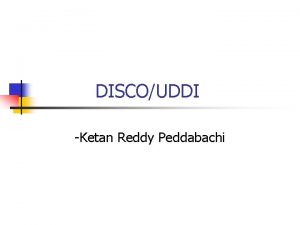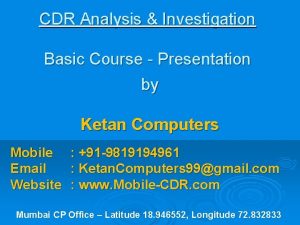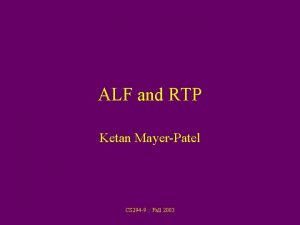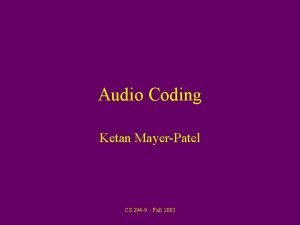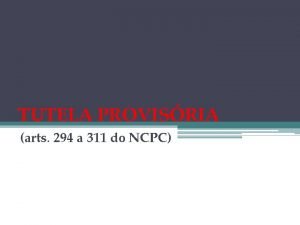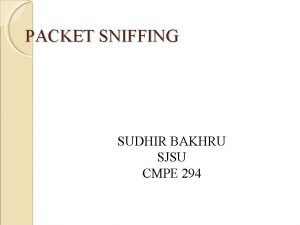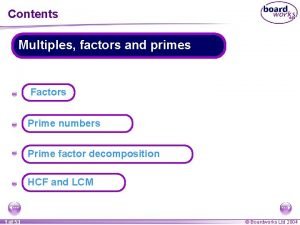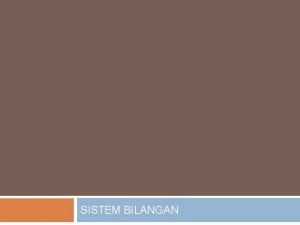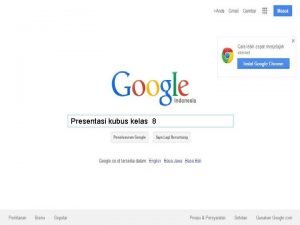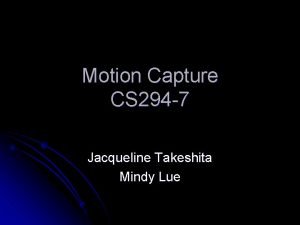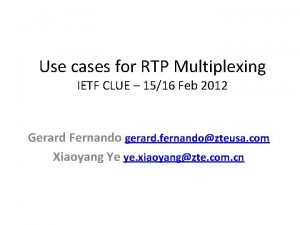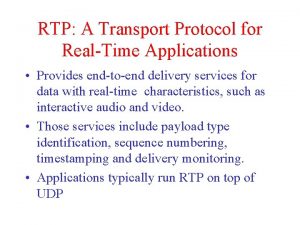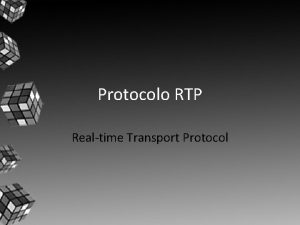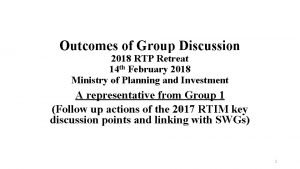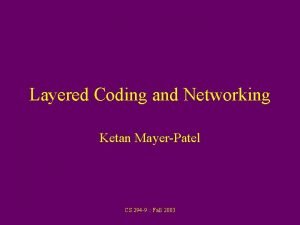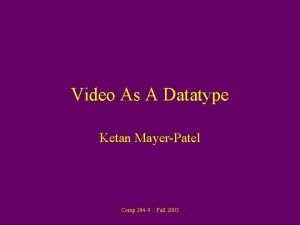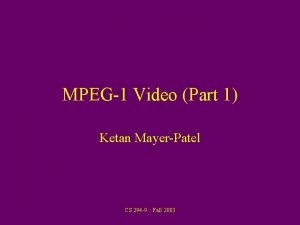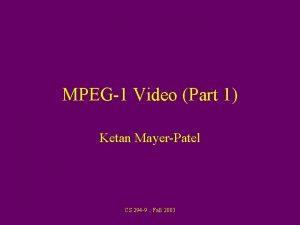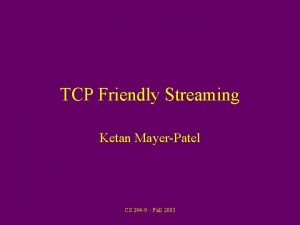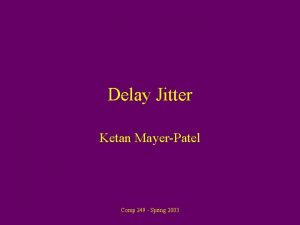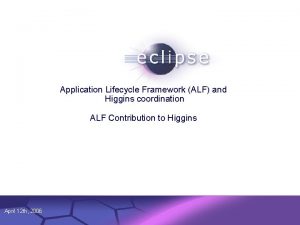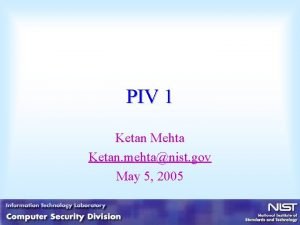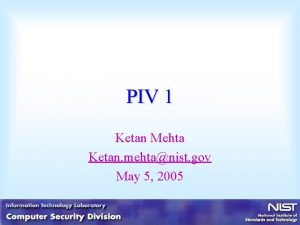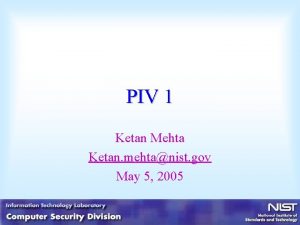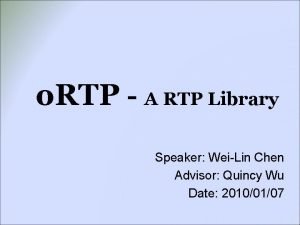ALF and RTP Ketan MayerPatel CS 294 9



















- Slides: 19

ALF and RTP Ketan Mayer-Patel CS 294 -9 : : Fall 2003

RTP Overview • Multiparty multimedia conferencing applications. – Applicable to most continuous media types. • Thin protocol – As is, doesn’t specify everything you need. – Serves as a skeleton that can be filled out. • Provides a handle on a few basic dimensions of a CM stream. – Allows functionality without full knowledge. CS 294 -9 : : Fall 2003

Application Level Framing • THE primary design principle behind RTP. • Clark and Tennenhouse, 1990 • Data should be organized into units that make the most sense for the application. – What makes sense for a video application? – What makes sense for a stock ticker? – What makes sense for an audio application? CS 294 -9 : : Fall 2003

ALF cont’d • Application Data Unit (ADU) • Interface to the network and the service model of protocols should be in terms of ADU’s. • Ex: TCP – What does it provide now? – What should it provide instead? CS 294 -9 : : Fall 2003

FLA (ALF run backwards) • Why don’t network mechanisms work in terms of ADU’s? • What can we do instead? – Let the applications construct ADU’s that fit the underlying network mechanism. – RTP provides a framework for doing this for continuous media streams. – Most common case: fitting the MTU CS 294 -9 : : Fall 2003

RTP Session Architecture • Multiple participants. – Possibly using multicast. • Multiple streams per participant. • Dynamic membership. – Participants come and go. • No assumption of central control. – Participants may not know about each other. CS 294 -9 : : Fall 2003

RTP Packet Format V=2 P X CC M PT Sequence Number Timestamp Synchronization Source (SSRC) Identifier Contributing Source (CSRC) Identifier Data CS 294 -9 : : Fall 2003

RTP and the Network Stack • Network protocols are layered. • What does RTP require from the layers underneath it? – Best effort delivery. – Length of packet. – Multiplexing among data types • What provides this? – UDP CS 294 -9 : : Fall 2003

SSRC • Identifies the stream. – Not just the participant. – All packets with the same SSRC go together. • Picked at random. • Why do we need this? – No assumption of stream association from underlying network mechanism. • Possible problems? – Collision CS 294 -9 : : Fall 2003

Timestamp vs. Sequence No. • Timestamp relates packet to real time. – Timestamp values sampled from a media specific clock. • Sequence number relates packet to other packets. • Allows many packets to have the same timestamp but different sequence numbers. CS 294 -9 : : Fall 2003

MPEG example • How does the timestamp/seq. no mechanism support MPEG? – Out of order transmission. • Sequence numbers increase monotonically. • Timestamps reflect reference relationships. – Large frames. • Natural ADU = frame. But that won’t work. • One video frame likely to be split into parts and packed into multiple RTP packets. • Timestamps associate packets together as part of the same frame, while seq. no distinguish packets from each other. CS 294 -9 : : Fall 2003

Audio silence example • Consider audio data type. – What do you want to do during silence? • Not send anything. – Why might this cause problems? • Other side needs to distinguish between loss and silence. – How does the timestamp/seq. no mechanism help? • After receiving no packets for a while, next packet received will reflect a big jump in timestamp, but have the correct next seq. no. Thus, receiver knows what happened. CS 294 -9 : : Fall 2003

RTP Profiles • Associated with a media type. • Provides association between PT field and specific media format. • Defines sampling rate of timestamp. • May also define or recommend a definition for the “marker” bit. CS 294 -9 : : Fall 2003

Video Profile • Marker bit recommended to mean last packet associated with a timestamp. • Timestamp clock: 90000 Hz • Defines PT mapping for a number of different video encoding types. CS 294 -9 : : Fall 2003

Audio Profile • Marker bit set on the first packet after a silence period where no packets sent. • Timestamp equals sampling rate. • Recommends 20 ms minimum frame time. • Recommends that samples from multiple channels be sent together. • Defines PT for a number of different audio encoding types. CS 294 -9 : : Fall 2003

RTP Payloads • Value of PT field given a particular profile identifies a payload type. • Each payload type associated with format specific definition for the rest of the packet. • Typically: – Format specific header. – Data CS 294 -9 : : Fall 2003

Payload Design Goals • Overall goal is to apply ALF principle as much as possible: – Each packet should be as independently processable as possible. • Loss • Out of order • Duplications – Payload definition should allow the application to fit RTP packets to the MTU. CS 294 -9 : : Fall 2003

RTP and Continuous Media • Periodic – Timestamp/Seq. no mechanism. • Robust – Media specific payload definitions that attempt to define packet-sized ADU’s. • Often large – Marker bit, timestamp/seq. no • Correlated – No real support. CS 294 -9 : : Fall 2003

ALF vs. Abstraction • Main message of the ALF paper: – Network should work in terms most congruent with what the application is trying to do. • Main obstacle to ALF: – Design of network mechanisms wants to hide details and provide general-purpose API’s. • Success of sockets • Abstraction and encapsulation • Tension between ALF and abstraction – What to expose? – How do we expose it? CS 294 -9 : : Fall 2003
 Pages 294 and 295
Pages 294 and 295 Ketan ramakrishnan
Ketan ramakrishnan Ketan reddy
Ketan reddy Ketan computers cdr analysis
Ketan computers cdr analysis Ketan mayer patel
Ketan mayer patel Ketan kotak
Ketan kotak Ketan mayer patel
Ketan mayer patel Art 294 a 311 cpc
Art 294 a 311 cpc Cmpe 294
Cmpe 294 Aaa 294
Aaa 294 99 as a product of prime factors.
99 as a product of prime factors. Konversikan bilangan desimal 294 menjadi bilangan biner
Konversikan bilangan desimal 294 menjadi bilangan biner In 1971 there were 294 105 females
In 1971 there were 294 105 females Rumus luas bidang diagonal kubus
Rumus luas bidang diagonal kubus Mindy lue
Mindy lue Mujaddid alf sani and two nation theory
Mujaddid alf sani and two nation theory Rtp multiplexing
Rtp multiplexing A transport protocol for real time applications
A transport protocol for real time applications Protocolo rtp
Protocolo rtp Retreat at rtp
Retreat at rtp


